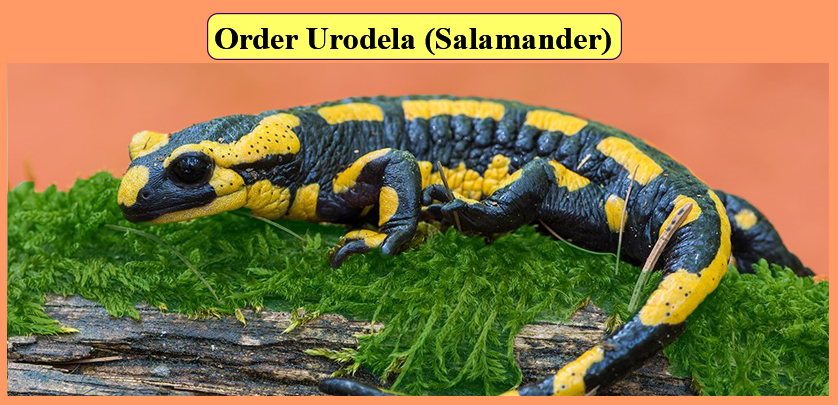
A tetrapod but not an amniote is
(a) Ostrich
(b) Shark
(c) Rattlesnake
(d) Salamander
(e) Kangaroo
Answer
557.4k+ views
Hint: Tetrapods are four-limbed vertebrates whereas amniote is a taxonomic group that contains all the tetrapods except for the amphibians. The amniotes lay eggs on the ground or let it develop inside the female organism.
Complete answer:
From the given options, the animal which is a tetrapod but not an amniote is a salamander. It is a four-limbed vertebrate but lays its eggs on land with amnion at the embryonic stage. There are other reptiles, birds, and mammals that have the same amniotic character i.e. lay their eggs inland or retain the fertilized eggs within the mother. The higher vertebrates of this type are tetrapods and have an egg equipped with an amnion.
Additional Information: Tetrapods are animals that have four limbs and include reptiles, mammals, and also some extinct amphibians. These are evolved from the tetrapodomorpha and are vertebrate tetrapodomorph land animals.

Although the snake's morphology isn't suitable for this category, they are still included in tetrapods because they evolved from animals that had four limbs.
On the other hand, amniotes are tetrapods and lay their eggs on the ground or retain the egg in a fertilized state within the mother. These are different from the amniotes which lay an egg in water. The characteristic feature of these is that they have an egg equipped with an amnion which is an adaptation to lay eggs on land rather than in water like an amnion. The embryo is protected by many layers of membrane and these tend to require a much larger food supply.
Therefore, the correct answer is “(d) Salamander”.
Note: Ostrich is a bird that isn't categorized in the tetrapod group as well as shark which belongs to Chondrichthyes. Rattlesnakes, although they lack four limbs, are considered tetrapods but they are not amniotic organisms. Kangaroo on the other hand is also a tetrapod that isn't considered an amniote.
Complete answer:
From the given options, the animal which is a tetrapod but not an amniote is a salamander. It is a four-limbed vertebrate but lays its eggs on land with amnion at the embryonic stage. There are other reptiles, birds, and mammals that have the same amniotic character i.e. lay their eggs inland or retain the fertilized eggs within the mother. The higher vertebrates of this type are tetrapods and have an egg equipped with an amnion.
Additional Information: Tetrapods are animals that have four limbs and include reptiles, mammals, and also some extinct amphibians. These are evolved from the tetrapodomorpha and are vertebrate tetrapodomorph land animals.

Although the snake's morphology isn't suitable for this category, they are still included in tetrapods because they evolved from animals that had four limbs.
On the other hand, amniotes are tetrapods and lay their eggs on the ground or retain the egg in a fertilized state within the mother. These are different from the amniotes which lay an egg in water. The characteristic feature of these is that they have an egg equipped with an amnion which is an adaptation to lay eggs on land rather than in water like an amnion. The embryo is protected by many layers of membrane and these tend to require a much larger food supply.
Therefore, the correct answer is “(d) Salamander”.
Note: Ostrich is a bird that isn't categorized in the tetrapod group as well as shark which belongs to Chondrichthyes. Rattlesnakes, although they lack four limbs, are considered tetrapods but they are not amniotic organisms. Kangaroo on the other hand is also a tetrapod that isn't considered an amniote.
Recently Updated Pages
Why are manures considered better than fertilizers class 11 biology CBSE

Find the coordinates of the midpoint of the line segment class 11 maths CBSE

Distinguish between static friction limiting friction class 11 physics CBSE

The Chairman of the constituent Assembly was A Jawaharlal class 11 social science CBSE

The first National Commission on Labour NCL submitted class 11 social science CBSE

Number of all subshell of n + l 7 is A 4 B 5 C 6 D class 11 chemistry CBSE

Trending doubts
Differentiate between an exothermic and an endothermic class 11 chemistry CBSE

10 examples of friction in our daily life

One Metric ton is equal to kg A 10000 B 1000 C 100 class 11 physics CBSE

Difference Between Prokaryotic Cells and Eukaryotic Cells

1 Quintal is equal to a 110 kg b 10 kg c 100kg d 1000 class 11 physics CBSE

State the laws of reflection of light




